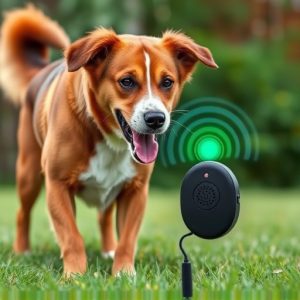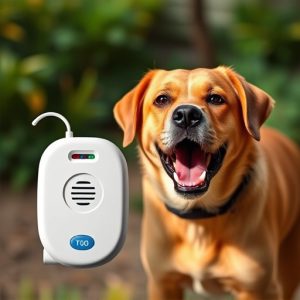Portable Dog Deterrent Systems: Effective Neighborhood Control Installation Guide
In urban areas, managing dog populations and maintaining harmony involves humane tools like portable…….
In urban areas, managing dog populations and maintaining harmony involves humane tools like portable dog deterrent systems. These devices, guided by the Portable Dog Deterrent Installation Guide, use sound technology to temporarily disorient dogs without harm. Options include ultrasonic repellers, spray deterrents, and electric fences, strategically placed in problem areas for effective control while adhering to ethical practices. Correct installation optimizes sound projection, preventing harm and distress. Regular maintenance, testing, adjustments, and training ensure the system's longevity and effectiveness.
Neighborhood dog control is a growing concern, with sonic equipment emerging as a non-lethal solution. This comprehensive guide delves into the world of portable dog deterrent systems, exploring their effectiveness and ethical considerations. Learn about different types, installation best practices, safety measures, and maintenance tips for these innovative devices. Discover how to implement a Portable Dog Deterrent Installation Guide for a quieter, more harmonious community.
- Understanding Neighborhood Dog Control: The Need for Sonic Equipment
- Types of Portable Dog Deterrent Systems: A Comprehensive Overview
- Installation Process: Step-by-Step Guide for Effective Placement
- Safety and Ethical Considerations: Using Sonic Equipment Responsibly
- Maintenance and Troubleshooting: Ensuring Longevity and Optimal Performance
Understanding Neighborhood Dog Control: The Need for Sonic Equipment
In many urban areas, managing dog populations and ensuring a peaceful environment for residents is a constant challenge. This is where neighborhood dog control comes into play, utilizing specific tools like portable dog deterrent systems. These innovative solutions offer a humane and effective method to address excessive barking and roaming, which can significantly disrupt community harmony.
The need for such equipment arises from the increasing number of pets in densely populated areas, often leading to noise pollution and potential safety concerns. A well-designed Portable Dog Deterrent Installation Guide can help residents implement tailored solutions. By employing sound technology, these devices emit specific frequencies that temporarily disorient dogs without causing harm, encouraging them to stay within designated boundaries. This approach not only promotes peaceful coexistence but also provides a practical alternative to more traditional, potentially harsh methods of dog control.
Types of Portable Dog Deterrent Systems: A Comprehensive Overview
Portable dog deterrent systems have evolved significantly, offering a range of options for effective and humane control. These devices are designed to keep dogs away from specific areas without causing them harm. One popular type is the ultrasonic dog repeller, which emits high-frequency sound waves that are unpleasant to dogs but inaudible to humans. These devices are easy to install and can be carried anywhere, making them a versatile choice for parks, gardens, and even homes with stray dog problems.
Another type is the spray deterrent, which uses a fine mist of water or a mild chemical solution to startle dogs without causing any physical harm. These systems can be manual or automatic, with motion sensors triggering the spray. For more targeted control, there are portable electric fences that use low-impedance shocks to deter dogs from entering certain areas. These options provide pet owners and communities with effective tools for managing dog behavior while adhering to humane practices, as recommended in a comprehensive Portable Dog Deterrent Installation Guide.
Installation Process: Step-by-Step Guide for Effective Placement
The successful installation of portable dog deterrent equipment is key to ensuring its effectiveness in controlling canine behavior. Here’s a simple step-by-step guide for proper placement. First, choose strategic locations within the problem areas of your neighborhood, such as parks, common spaces, or residential front yards where stray dogs are known to congregate or cause disturbances. These devices operate on sound waves, so positioning them at eye level and ensuring line-of-sight to potential problem areas is crucial.
Next, secure the equipment firmly according to the manufacturer’s instructions. Typically, this involves driving stakes into the ground to hold up the portable units. Ensure they are stable enough to withstand external factors like wind. Once installed, test the devices’ functionality and range to make sure they cover the desired area effectively. Proper installation will optimize the device’s sound projection, creating a deterring effect on dogs without causing harm or distress.
Safety and Ethical Considerations: Using Sonic Equipment Responsibly
When considering a portable dog deterrent installation guide, it’s paramount to balance effectiveness with safety and ethical considerations. Sonic equipment designed to deter dogs operates on high-frequency sound waves that are inaudible to humans but can provoke a reaction from canine senses. However, irresponsible use could lead to unexpected harm or stress for pets and people alike. Always ensure the device is used in accordance with manufacturer guidelines, focusing on targeted areas away from human dwelling spaces and public access points.
Ethical usage involves respecting the well-being of all inhabitants within the neighborhood. Test the equipment first to ensure its effectiveness without causing undue distress. Maintain proper training and supervision during operation, and consider alternative methods like signage or fencing if suitable. Regular monitoring and adjustments are crucial to prevent any adverse effects while achieving the desired level of canine control.
Maintenance and Troubleshooting: Ensuring Longevity and Optimal Performance
Proper maintenance and troubleshooting are key to ensuring your portable dog deterrent installation guide stays in top condition, maximizing its lifespan and performance. Regular cleaning is essential to remove any buildup or debris that could affect sound quality and range. Check all connections periodically, tightening loose ones, and replacing worn-out parts promptly. A well-maintained unit will not only deter dogs more effectively but also save you from frequent repairs.
When issues arise, a systematic troubleshooting approach can often resolve them quickly. Start by inspecting the power source, ensuring it’s functioning correctly. Test each component individually, like speakers, amplifiers, and control panels, to pinpoint problematic areas. Many manufacturers provide detailed troubleshooting guides in their manuals, making it easier to diagnose and fix common problems. Regular maintenance and these problem-solving skills will help keep your portable dog deterrent installation running smoothly, providing effective protection for years to come.
Implementing a portable dog deterrent system can effectively manage canine behavior in shared living spaces, but it requires thoughtful consideration and responsible usage. By understanding the technology, choosing the right equipment, and following the detailed installation guide (Portable Dog Deterrent Installation Guide), neighbors can create a harmonious environment for everyone. Maintaining and troubleshooting these devices responsibly ensures their longevity and effectiveness while respecting the well-being of both pets and people in the neighborhood.


